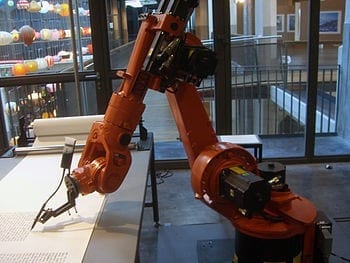
A recent study investigates how readers perceive computer-generated news articles.
The advent of new technologies has always spurred questions about changes in journalism – how it is produced and consumed. A recent development which has come to the fore in the digital world is software-generated content. A paper recently published in Journalism Practice investigates how readers perceive automatically produced news articles vs. articles which have been written by a journalist.
The study, undertaken by Christer Clerwall of Karlstad University in Sweden, was conducted by presenting readers with different articles written by either journalists or computers. The readers were then asked to answer questions about how they perceived each article – e.g. the overall quality, credibility, objectivity.
The results suggest that the journalist-authored content was observed to be coherent, well-written and pleasant to read. However, while the computer generated content was perceived as descriptive and boring, it was also considered to be objective and trustworthy. Overall readers found it difficult to tell which articles had been written by journalists, and which were software-generated.
Perhaps most significant in Clerwall’s study is the discovery that there were no substantial differences in how the different articles were perceived by readers. Does that mean that computer robots are capable of doing as good a job as journalists? Should journalists be considering a career change just yet? There are certainly advantages to be had in the speed with which computer-generated content can be produced, but will a robot writer ever be able to match the creativity, flexibility and analysis of journalist authored articles? The technology in place may not be quite able to reach these levels of sophisticated reporting yet, but it certainly provides food for thought as to how automated content might influence journalism in the future.
The Latest on: Computer-generated news articles
[google_news title=”” keyword=”Computer-generated news articles” num_posts=”10″ blurb_length=”0″ show_thumb=”left”]
via Google News
The Latest on: Computer-generated news articles
- Alabama targets ‘deepfake,’ computer-generated child pornographyon May 8, 2024 at 4:12 pm
Demopolis resident Tiffany Cannon was shocked to learn that someone had used artificial technology to make pornographic images of her middle school daughter. As of Oct 1, when the Alabama Child ...
- House bill targets AI-generated comments in rulemakingon May 8, 2024 at 1:46 pm
The House passed a bill on Monday that tasks federal agencies with managing computer-generated comments in rulemaking proceedings. The Comment Integrity and Management Act of 2024 passed without ...
- Video of 'cloud seeding' truck in Dubai is computer-generatedon May 8, 2024 at 9:54 am
Social media users are sharing a video of a truck speeding through Dubai while enveloped in clouds alongside claims that weather modification programs triggered the deadly floods that hit the United ...
- Novelist J.G. Ballard Was Experimenting With Computer-Generated Poetry 50 Years Before Chatgpt Was Inventedon May 7, 2024 at 11:49 am
The novelist and short story writer J.G. Ballard , is known for conjuring warped and reimagined versions of the world he occupied. Dealing with stra ...
- We're Losing Our Minds at This "Computer Generated" Sketch of a Police Suspecton May 2, 2024 at 6:06 am
Except in this case, the local fuzz opted for a "computer generated" image, which they shared on X-formerly-Twitter. And the results, we have to say, are absolutely comical. Whether it turns up ...
- We're Losing Our Minds at This "Computer Generated" Sketch of a Police Suspecton May 2, 2024 at 6:06 am
There's a potential burglar on the loose. We suspect, though, that he doesn't quite look how the cops imagine him to be. On the hunt for a man who may have broken into a 90-year-old homeowner's house ...
- Why you’ll soon have a digital clone of your ownon May 2, 2024 at 3:00 am
One early digital influencer on Instagram, named Lil Miquela, has been 19 years old since 2016, is worth millions of dollars and was named one of the 25 most influential people on the Internet back in ...
- Police’s Computer-Generated Image Is Giving People Real Pete Buttigieg Vibeson April 30, 2024 at 9:50 am
Transportation Secretary Pete Buttigieg is the latest public figure whose (potential) lookalike is being sought by police in England. Investigators in the southeast town of Tunbridge Wells on Monday ...
- Computer-generated fake nudes discovered by victims on the internet, Florida cops sayon April 23, 2024 at 12:08 pm
Hillsborough County is home to Tampa. “The computer-generated images were made from the original clothed images of the victims posted on social media platforms,” the sheriff’s office reports.
- Computer-generated fake nudes discovered by victims on the internet, Florida cops sayon April 23, 2024 at 12:08 pm
Mark Price is a National Reporter for McClatchy News. He joined the network of newspapers in 1991 at The Charlotte Observer, covering beats including schools, crime, immigration, LGBTQ issues, ...
via Bing News










